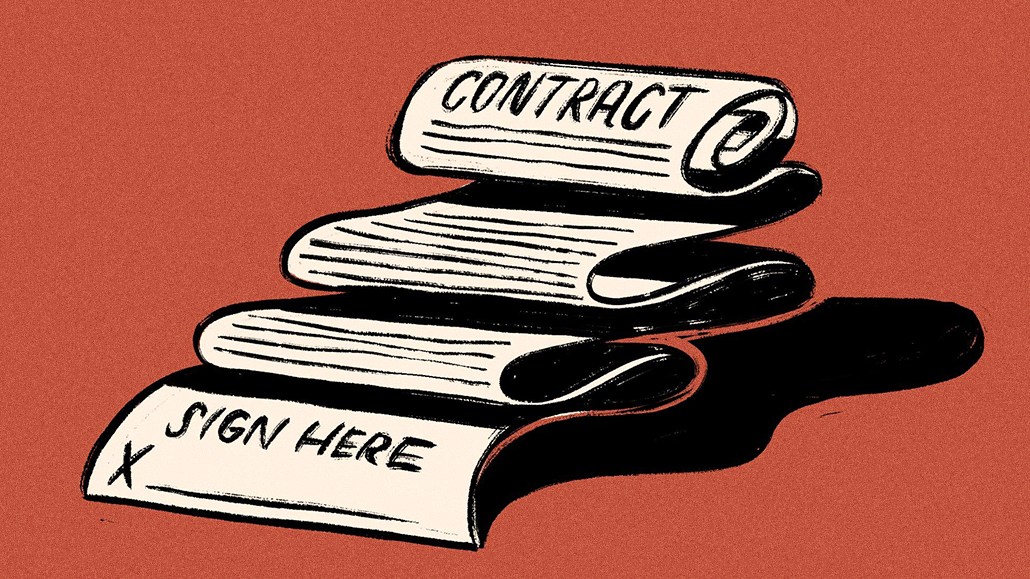Connect with execs from The New York Times, TIME, Dotdash Meredith and many more

This article is a WTF explainer, in which we break down media and marketing’s most confusing terms. More from the series →
The ad agency world knows it may have a problem on its hands if the Association of National Advertisers issues a report about some practice those agencies are using.
The latest iteration of that reality came out earlier in May when the ANA published the report, “The Acceleration of Principal Media (What Marketers Need to Know),” which tackled the growing practice among agencies of investing in media at non-disclosed prices to then resell to their clients, presumably at a markup to the agency.
The use of principal media is on the rise, notably by the agency holding companies, which are looking for profit wherever they can find it. As Jay Pattisall, vp and senior agency analyst at Forrester puts it, “That’s what’s driving the growth among those agencies that are demonstrating it.”
Surprisingly, the ANA report that examines the practice is surprisingly moderate in its tone, acknowledging that agencies are within their rights to find profit and margins where they can, given that marketers have limited agencies’ compensation and revenue through procurement and longer payment terms, among other factors. Ultimately, the report’s conclusion is to remind marketers to closely monitor their contracts with agencies to ensure as much transparency as possible — although that degree depends on which side of the contract you’re on.
“I think there’s a lot of fear mongering in the industry around proprietary media, and that it can be a win win win for the media owner, for the agency and for the client,” said Cyd Falkson, business director for MediaSense. “So long as everyone is aware of what everyone has to gain and there are governance models in place.”
Not to be confused with the upfront marketplace, or for that matter, the barter trade business (although the two have similarities — more on that below), principal media takes on a variety of forms, from direct investment in ad inventory by agencies of their media vendors, to more indirect commitments to invest at certain rates. The ANA report notes that the practice has been around for at least a decade.
So what does principal media do?
Essentially it’s when an agency (most often a media agency) doesn’t act as an agent but rather as a principal by selling ad inventory it has purchased from a media vendor/publisher to its client and earns some profit margin off of that sale.
There are a few different ways that agencies make this happen. In some cases, they purchase specific unit-based inventory, while other times they commit a certain investment over a certain time horizon with an expectation that the vendor sells it at a discounted rate. By either investing in or committing to invest in ad inventory in those media channels, the seller gives the investing agency a reduced rate to purchase.
This is what changes the nature of the agency to becoming a principal rather than an agent, in that they control the inventory purchased, which they then offer to their clients.
Independent analyst Brian Wieser offers an excellent breakdown of other forms of principal media in a recent issue of his Madison and Wall newsletter.
What has raised the hackles of some in marketing is that the agency does not disclose what it paid to the client — a factor that leads some in the industry to suspect agencies of putting their own interests ahead of their clients’. Perhaps the best quote comes from the ANA report, in which one respondent to the survey said, “I don’t know if my agency is recommending principal media because it’s the best media for me, or the best media for them.”
Although he understands the need for agencies to find value where they can, Forrester’s Pattisall isn’t a huge fan of principal media. “The marketplace is looking at principal media through the wrong lens,” he said. “The lens should be: what is right for the client’s brand, the client’s audiences and ultimately driving the client’s growth. Is that acquiring inventory at a discount that may or may not apply? Or is that tailoring the execution specific to the audiences that you’re trying to reach? And I firmly believe it’s the latter.”
But one holding company said that its clients that use it actually want to use it. “Clients who engage are typically actively seeking these opportunities,” said one holding company source who wasn’t authorized to speak on the record.
Are all holding companies and big agencies doing it?
Omnicom and Publicis are the two main holding companies to actively pursue the practice — and it’s not a coincidence they are also the two holdcos in the best financial condition. But there are more reasons for their success beyond just the use of principal media investment.
Both holding companies declined to comment for this story. Other holding companies Digiday reached out to didn’t return emails seeking comment.
But others are engaging in the practice, and they all seem to find their own way, as are some of the larger independent media agencies. As Greg James, U.S. CEO of Havas Media Network told Digiday recently, “Havas’ principal-based buying solution, HVP, was created to differentiate itself from other agency holding company offerings in a few key ways — transparency, media quality and flexibility. We see overall a net-positive impact from this position in certain situations — always with transparent discussion with clients, procurement and legal, and always with true flexibility.”
Independent Crossmedia, part of the Dawn collective of agencies, wrote in a recent LinkedIn post: “[W]e never compromise neutrality or engage in principal based buying … we have a solution that turns principal based buying into procurement based buying. The Cross Connect is designed to be a fully transparent, triple opt-in, triple-bid marketplace that secures quality inventory at principal rates. And the best part, the client knows exactly what they are paying for.”
How, if at all, does the client benefit?
Here’s where there are a few ways of looking at principal media. The optimist would say clients get bargain-basement pricing for sometimes premium inventory because the agency secured it for them. The pessimist says if the agency got a deal but then marks it up for the client — and doesn’t share with them how much margin it made — then it’s no longer acting in their best interests.
MediaSense’s Falkson argues more the former, saying the client gets “advantageous” pricing that helps them reach better CPM blends, while also giving them access to inventory that might have otherwise been too expensive. And she points out that the fringe benefit can be that, if agency and client know the agency made margin, the client might be able to ask for fee relief in other areas of their working arrangement.
For their part, holding companies say the benefits are numerous. “Every investment unlocks benefits, depending on need — whether it’s media savings and reinvestment; guaranteed outcomes; media testing and innovation; creative content and production; non-working media improvements (e.g., research, tech production, etc.); or funding key corporate business initiatives,” said the holding company exec.
Why wouldn’t clients just add clauses to their contracts?
They would, and that’s the main thrust of the ANA report, whose survey respondents showed how little is understood by marketers in the practice. Nearly one in five marketers the survey spoke with even knew what principal media was.
John Sheehy, former president of global clients at Publicis Media and current operating partner of investment firm NewRoad Capital Partners, said it’s up to the clients to add the wording or to head the agency off at the pass.
“When you go into a contract with a client, you know, some clients say, you know, no, I don’t want to participate in that,” he said. “Some clients say yes, but I want to make sure that I have audit rights, and to have accountability for media metrics and beyond — business outcomes.”
So how is this different from barter?
There are similarities, no doubt, in that both principal media and barter media have the agency acting as principals. The primary differences include the fact that most inventory sold in barter is either remnant or last-minute inventory, and that compensation for barter comes in the form of some physical product — could be bushels of apples, could be Herman Miller office chairs. In principal media, the primary form of compensation is monetary.
How do publishers/media media companies benefit, if at all?
Besides selling inventory that creates tightness in the rest of your inventory, media companies can benefit by possibly attracting a client they otherwise hadn’t been able to crack. “To have an agency be able to add [that client] to your plan at a one-time or two-time-only discounted rate then it’s financially advantageous for them to trial you,” said Falkson. “Then you have an in with a new advertiser and might be able to sell to them again.”
Who’s taking the most risk with the practice?
Arguably it’s the agency, explained NewRoad Capital Partners’ Sheehy.
It’s not so much that [agencies] are just trying to find the cheap dollar, pass it on and make some margin,” said Sheehy. “They’re trying to take advantage of some of these efficiencies on behalf of their clients so they can pass on some savings, maybe take some savings and help their margin no doubt. But they take the risk — it’s their dollars in the marketplace so if they don’t sell or the inventory runs out, S.O.L., baby.”
Will the practice continue?
Without a doubt. Said the holding company source: “We see it continuing to grow, but more importantly, evolve, as more clients expect their partners to assume more risk and as more brands demand flexibility in this dynamic marketplace. We continue to evolve the offerings into content, intersecting areas like media+production and definitely the AI-driven future.”
More in Media Buying

Ad Tech Briefing: How ad tech underpins the fate of Madison Avenue’s ‘Wedding of the Year’
The ‘brand safety’ debate is threatening to derail the IPG-Omnicom merger, while questions are raised on the integration of Annalect and Acxiom.

Media Buying Briefing: Are holdcos at a tipping point, or is this just another bump in the road?
WPP picks its new CEO but has a struggling business to shore up, while Omnicom and IPG deal with losing key executives in the leadup to their union.

Omnicom confirms the pending exit of influential Annalect chief Slavi Samardzija
The CEO and architect of Omni departs, hinting at pending changes as Omnicon continues $13.5 billion IPG takeover bid.








